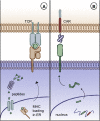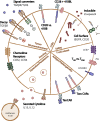Engineering for Success: Approaches to Improve Chimeric Antigen Receptor T Cell Therapy for Solid Tumors
- PMID: 30796733
- PMCID: PMC6613829
- DOI: 10.1007/s40265-019-01071-7
Engineering for Success: Approaches to Improve Chimeric Antigen Receptor T Cell Therapy for Solid Tumors
Abstract
While impressive clinical responses have been observed using chimeric antigen receptor (CAR) T cells targeting CD19+ hematologic malignancies, limited clinical benefit has been observed using CAR T cells for a variety of solid tumors. Results of clinical studies have highlighted several obstacles which CAR T cells face in the context of solid tumors, including insufficient homing to tumor sites, lack of expansion and persistence, encountering a highly immunosuppressive tumor microenvironment, and heterogeneous antigen expression. In this review, we review clinical outcomes and discuss strategies to improve the antitumor activity of CAR T cells for solid tumors.
Conflict of interest statement
Melinda Mata has no conflict of interest; she is currently an employee of Immatics US, Inc. Stephen Gottschalk has patents and patent applications in the field of T cell therapy and gene therapy for cancer, is a consultant of ViraCyte, LLC, a member of the data safety monitoring board of Immatics US, Inc., and received research funding from Tessa Therapeutics LTD.
Figures




Similar articles
-
Chimeric antigen receptor-engineered T-cell therapy for liver cancer.Hepatobiliary Pancreat Dis Int. 2018 Aug;17(4):301-309. doi: 10.1016/j.hbpd.2018.05.005. Epub 2018 May 24. Hepatobiliary Pancreat Dis Int. 2018. PMID: 29861325 Review.
-
CAR-T cell therapy in melanoma: A future success story?Exp Dermatol. 2018 Dec;27(12):1315-1321. doi: 10.1111/exd.13792. Exp Dermatol. 2018. PMID: 30288790
-
Comprehensive clinical evaluation of CAR-T cell immunotherapy for solid tumors: a path moving forward or a dead end?J Cancer Res Clin Oncol. 2023 Jun;149(6):2709-2734. doi: 10.1007/s00432-022-04547-4. Epub 2022 Dec 24. J Cancer Res Clin Oncol. 2023. PMID: 36564524 Free PMC article. Review.
-
CAR-T Cells and Oncolytic Viruses: Joining Forces to Overcome the Solid Tumor Challenge.Front Immunol. 2018 Oct 23;9:2460. doi: 10.3389/fimmu.2018.02460. eCollection 2018. Front Immunol. 2018. PMID: 30405639 Free PMC article. Review.
-
Making CAR T Cells a Solid Option for Solid Tumors.Front Immunol. 2018 Nov 8;9:2593. doi: 10.3389/fimmu.2018.02593. eCollection 2018. Front Immunol. 2018. PMID: 30467505 Free PMC article. Review.
Cited by
-
CAR T-Cells Targeting the Integrin αvβ6 and Co-Expressing the Chemokine Receptor CXCR2 Demonstrate Enhanced Homing and Efficacy against Several Solid Malignancies.Cancers (Basel). 2019 May 14;11(5):674. doi: 10.3390/cancers11050674. Cancers (Basel). 2019. PMID: 31091832 Free PMC article.
-
Tuning the Antigen Density Requirement for CAR T-cell Activity.Cancer Discov. 2020 May;10(5):702-723. doi: 10.1158/2159-8290.CD-19-0945. Epub 2020 Mar 19. Cancer Discov. 2020. PMID: 32193224 Free PMC article.
-
Current status and hurdles for CAR-T cell immune therapy.Blood Sci. 2019 Oct 21;1(2):148-155. doi: 10.1097/BS9.0000000000000025. eCollection 2019 Oct. Blood Sci. 2019. PMID: 35402809 Free PMC article.
-
IL-21 Optimizes the CAR-T Cell Preparation Through Improving Lentivirus Mediated Transfection Efficiency of T Cells and Enhancing CAR-T Cell Cytotoxic Activities.Front Mol Biosci. 2021 Jun 4;8:675179. doi: 10.3389/fmolb.2021.675179. eCollection 2021. Front Mol Biosci. 2021. PMID: 34179083 Free PMC article.
-
Rewriting History: Epigenetic Reprogramming of CD8+ T Cell Differentiation to Enhance Immunotherapy.Trends Immunol. 2020 Aug;41(8):665-675. doi: 10.1016/j.it.2020.06.008. Epub 2020 Jul 2. Trends Immunol. 2020. PMID: 32624330 Free PMC article. Review.
References
Publication types
MeSH terms
Substances
Grants and funding
LinkOut - more resources
Full Text Sources

